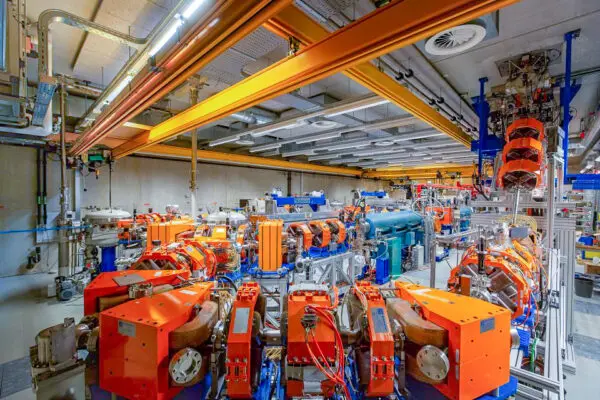
Dr. Giel Berden
Meer info over Giel
 Naar de hoofdinhoud
Naar de navigatie
Naar de hoofdinhoud
Naar de navigatie
In ons lab staan ook vier vrije-elektronenlasers, die licht produceren in het infrarood. Onze lasers zijn zeer intens en hebben een ongekend golflengtebereik. Wanneer we deze lasers richten op moleculen en materialen, ontstaat er een interactie die ons zeer gedetailleerde informatie geeft over hun structuur en (elektronische) eigenschappen. Deze experimenten dragen bij aan aanbrekend onderzoek in verschillende onderzoeksvelden. Bijvoorbeeld binnen de geneeskunde, materiaalkunde en astrochemie.

| e-beam energy | 50/45 – 15 MeV |
| Spectral range | 2.7 – 150 μm 3600 – 66 cm-1 120 – 2 THz 450 – 8 meV |
| Micropulse rep. rate | 25/50/100/1000 MHz |
| Macropulse rep. rate | < 10 Hz |
| Micropulse energy | < 40 uJ |
| Macropulse energy | < 100 mJ @ 1 GHz |
| Peak power | 150 MW |
| Polarization (linear) | > 95% |
| Spectral bandwidth (FWHM) | 0.4 – 5 % |
| Micropulse duration (FWHM) | 8 – 100 optical cycles |
| Corresponding Pulsewidth | 0.25 – 6 ps @ 10 μm |
| e-beam energy | 15 – 10 MeV |
| Spectral range | 100 – 1500 μm 100 – 6.6 cm-1 3 – 0.2 THz 12 – 0.8 meV |
| Micropulse rep. rate | 20, 40, 60 or 3000 MHz |
| Macropulse rep. rate | < 10 Hz |
| Micropulse energy | < 5 uJ |
| Macropulse energy | < 100 mJ |
| Peak power | 0.1 MW |
| Polarization (linear) | > 95 % |
| Spectral bandwidth (FWHM) | ≈ 1 % |
| Micropulse duration (FWHM) | ≈ 40 optical cycles |
| Corresponding Pulsewidth | 70 ps @ 500 μm |
| e-beam energy | 50/45 – 15 MeV |
| Spectral range | 5-100 μm 2000 – 100 cm-1 60 – 3 THz 250 – 12 meV |
| Micropulse rep. rate | 16.6, 50, or 1000 MHz |
| Macropulse rep. rate | < 10 Hz |
| Micropulse energy | < 1000 uJ |
| Macropulse energy | < 5000 mJ |
| Peak power | 3 MW |
| Polarization (linear) | > 95 % |
| Spectral bandwidth (FWHM) | 0.5 – 3 % |
| Micropulse duration (FWHM) | 13 – 80 optical cycles |
The Laboratory Ice Surface Astrophysics (LISA) end-station, designed and built in 2019 at the HFML-FELIX Laboratory in collaboration with Queen Mary University of London, is a state-of-the-art ultra-high vacuum (UHV) setup for investigating solid-phase, space-relevant molecules under simulated interstellar conditions. Now permanently located at User Station 1, LISA is operated and managed by Dr. S. Ioppolo, currently based at Aarhus University.
LISA is optimized for coupling with FEL-1 and FEL-2 for IR/THz irradiation experiments on astrophysical ices. It features a dedicated UHV dosing line for the preparation and deposition of pure gases and gas mixtures onto a gold-coated, optically flat OFHC copper substrate cooled by a closed-cycle helium cryostat (temperature range: 8–450 K). A rotation stage and XYZ-manipulator allow precise alignment and multi-spot irradiation of a single sample, enabling reproducible and systematic studies across beamtime shifts.
Analytical capabilities include in-situ Fourier-Transform Infrared (FTIR) spectroscopy using a Bruker Vertex 80v in reflection-absorption mode. The spectrometer’s rapid scan mode supports time-resolved acquisition (>100 spectra/second) for tracking dynamic spectral changes during FEL irradiation. Additionally, a HAL/3F RC PIC quadrupole mass spectrometer is equipped with a Multi-Channel Scaler (MCS) for micro- and sub-microsecond resolved detection of photo-induced desorption events, allowing real-time monitoring of desorbing species from the ice surface.
Supplementary tools such as a 5 keV electron gun and an OLED Effusion Cell expand LISA’s capability to simulate energetic processing and deposit complex organic materials. As a uniquely capable platform, LISA plays a crucial role in exploring the physicochemical evolution of cosmic ices, bridging laboratory astrophysics with ALMA and JWST observations of star-forming regions.
LISA has demonstrated broad applicability in ice astrophysics and has supported research teams from institutions including Heriot-Watt University (UK), Leiden University (NL), PRL India, and Aarhus University (DK). Studies performed with LISA include:
The Laboratory Ice Surface Astrophysics (LISA) end-station, designed and built in 2019 at the HFML-FELIX Laboratory in collaboration with Queen Mary University of London.
LISA is operated and managed by Dr. S. Ioppolo, currently based at Aarhus University.

Meer info over Giel

Meer info over Sandra
User-Station 2 houses a continuously-amplified fiber laser that can deliver pulses either “on-demand” or at repetition rates between 10 Hz and 50 MHz. These pulses, in the visible to near-infrared spectral range, are synchronized to the FELIX micropulses, facilitating two-color pump-probe experiments.
In this user-station, we are also constructing a portable setup that will allow for two-color pump-probe experiments, using mid-/far-infrared pump pulses and near-infrared/visible probe pulses, to be performed within the bore of the magnets at HFML.
Condensed matter physics: two-color pump-probe microscopy, using infrared pump pulses in combination with ultrashort visible to near-infrared probe pulses.
HFML-FELIX

Meer info over Andrei
The laser combination of User Station 3 provides possibilities to measure dynamic properties of condensed matter systems in the broadest spectroscopic range. On the one hand, the radiation of all of the FELIX lasers is delivered to the optical table. On the other, a synchronized Ti:sapphire amplifier with short and high-energy pulses (25 fs, 2 mJ) can be used to probe the result of the excitation via various optical effects, from absorption and transmission, to birefringence and Faraday rotation of polarization, and to optical second harmonic generation. Moreover, its pulses can be used to generate high optical harmonics, bringing the photon energy to EUV and soft-X-ray range, that can also be used as a probe.
Such measurements can also be done in the temperature range of 10-350 K and in an applied magnetic field.
HFML-FELIX

Meer info over Carl
Meer informatie volgt snel.

Meer info over Nils
The BUMA instrument is dedicated to perform (far-)infrared spectroscopy on gas-phase neutral species. The aimed systems include carbon- and sulfur-bearing molecules with astrochemical relevance, such as carbon clusters, fullerenes, PAH-derivatives and sulfur allotropes, focusing on their infrared fingerprints for identification in space and the search of biosignatures on exoplanets. Elucidating the key intermediate steps in the catalytic pathways of organocatalysts is also at the center of research at BUMA. Moreover, we focus on understanding the conformational dynamics of weakly-bound complexes, such as clusters of PAHs and complexes between carbon-bearing species and small molecules like water and carbon dioxide.
The instrument is based on time-of-flight mass spectrometry. Non-volatile molecular species are brought into the gas phase using laser desorption, whereas molecular beams of volatile species are formed in a pulsed source equipped with resistive heating, which in addition can be coupled to an electrical discharge. The gas phase molecules are subsequently cooled down in a supersonic expansion, resulting in intact, cold, neutral molecules. Different ionization schemes can be employed, by combining a variety of VIS/near-UV lasers. Species can be probed by using conformer-selective ion-dip spectroscopy or infrared multiple photon dissociation spectroscopy, in the wide region from about 100 to 4000 cm-1.
HFML-FELIX

Meer info over Piero
The FELion cryogenic 22-pole ion trap instrument allows the gas-phase infrared spectroscopic characterization of mass-selected, internally and kinetically cold (T > 4K) molecular ions by different infrared action spectroscopic methods, e.g., rare-gas tagging or InfraRed PreDissociation (IRPD), Leak-Out Spectroscopy (LOS), Laser Induced Reactions (LIR), Infrared Multiple Photon Dissociation (IRMPD). The cold temperatures of the molecular ions result in high-resolution infrared spectra, only limited by the FEL linewidth, of molecular anions and cations up to m/z of around 300.
The instrument is equipped with two electron impact ionization sources, one having storing capabilities allowing to form protonated forms of neutral species, negative molecular ions, and ionic products of (high-temperature) ion-molecule reactions. A large variety of molecular anions and cations can thus be spectroscopically and structurally characterized, as long as the vapor pressure of their neutral precursor exceeds ~10-5 mbar (with moderate heating to around 100°C). In some cases, in-situ spectroscopic probing of intermediates and products of cold ion-molecule reactions inside the cryogenic ion trap is possible.
The FELion instrument was designed and built in and is still owned by the group of Prof. S. Schlemmer, University of Cologne (Germany). Special access rules may apply. Operation supported by the Cologne Center for Terahertz Spectroscopy funded by the Deutsche Forschungsgemeinschaft (DFG, grant SCHL 341/15-1).

Meer info over Sandra
Deze locatie wordt momenteel niet als onderzoeksruimte gebruikt.
The optical table in User Station 8 provides a place for general-purpose optical experiments, both with and without FELIX radiation. Examples include a polarized light microscope for imaging of domain structures in various ferroic samples and magneto-optical Kerr and Faraday setup for studying hysteresis loops of various magnetized samples. As the probe light, several CW lasers are available, with wavelengths 450, 633, and 1064 nm, with 50-500 mW power. These measurements can be done in magnetic fields up to 2 Tesla in various geometries. A quadrupole electromagnet can configured to apply magnetic field in any direction in sample plane. Moreover, a helium flow cryostat can be used to perform measurement in a temperature range of 4 K to 350 K.
HFML-FELIX

Meer info over Andrei
The quadrupole ion trap lab is home of three commercial Bruker Amazon Speed ETD ion trap mass spectrometer, which have been modified to enable optical access to the ions stored in the trap. Each of the instruments can be used with an analytical electrospray ionization source or alternatively an atmospheric pressure chemical ionization source. A key advantage is its high sensitivity; typical sample concentrations are in the 10-5 – 10-8 M range. MS and IR experiments can be coupled with liquid chromatography (Bruker Elute) to enable the measurement of low abundance components in complex mixtures such as body fluid samples. The quadrupole ion trap mass spectrometer has many MSn options, including multiple stages of CID and (single stage) ETD. Interfacing of the electronics and software of the MS with that of FELIX to enable automated IR spectra collection has been installed.
Combining the individual analytical strengths of mass spectrometry and infrared spectroscopy, infrared ion spectroscopy is increasingly recognized as a powerful tool for small-molecule identification in a wide range of analytical applications. Mass spectrometry is itself a leading analytical technique for small-molecule identification on the merit of its outstanding sensitivity, selectivity and versatility. The foremost shortcoming of the technique, however, is its limited ability to directly probe molecular structure, especially when contrasted against spectroscopic techniques. In infrared ion spectroscopy (IRIS), infrared vibrational spectra are recorded for mass-isolated ions and provide a signature that can be matched to reference spectra, either measured from standards or predicted using quantum-chemical calculations.
HFML-FELIX

Meer info over Giel

Meer info over Jos
Infrared ion spectroscopy experiments are performed on a modified FT-ICR MS (SolariX XR, Bruker Daltonics) equipped with a 7 T superconducting magnet. Ions can be generated by atmospheric pressure ionization (API) or laser desorption ionization (LDI) sources. The API interface can be equipped with an ESI (Apollo II ESI) or APCI source (Apollo II APCI or DIP-APCI). The FT-ICR MS is equipped with a trapped ion mobility spectrometry (TIMS) stage. The instrument allows one to record infrared multiple-photon dissociation (IRMPD) spectra for mass and mobility selected ions. Additionally, matrix-assisted laser desorption/ionization (MALDI) with IRIS allows direct analysis of small molecules from biological tissues.
Combining the individual analytical strengths of mass spectrometry and infrared spectroscopy, infrared ion spectroscopy is increasingly recognized as a powerful tool for small-molecule identification in a wide range of analytical applications. Mass spectrometry is itself a leading analytical technique for small-molecule identification on the merit of its outstanding sensitivity, selectivity and versatility. The foremost shortcoming of the technique, however, is its limited ability to directly probe molecular structure, especially when contrasted against spectroscopic techniques. In infrared ion spectroscopy (IRIS) at the FT-ICR MS, infrared vibrational spectra are recorded for mass-isolated and ion mobility selected ions and provide a signature that can be matched to reference spectra, either measured from standards or predicted using quantum-chemical calculations.
HFML-FELIX

Meer info over Giel

Meer info over Jonathan
User station 11 is broadly used to study the effects of infrared radiation on solid-state samples, including (but not limited to) magnetic materials, ferroelectrics, liquid crystals, semiconductors and ferroelastics. The infrared pulses delivered by FELIX are generally used to pump the aforementioned materials, while visible and near-infrared light is used to probe the resulting effects.
Here, we combined two-colour pump–probe experiments with FEL beam used as a pump and multiple probing options giving an insight into mid-Infrared induced effects and its dynamics on a nanosecond and microsecond timescale. This area is designated for building home-made microscopes that can temporally- and spatially resolve the effects induced by the infrared radiation. We are specialized in measuring birefringence and Faraday rotation with polarization microscopy, and second harmonic generation with a second harmonic generation microscope. We routinely modify the setup to allow for integration of a He cryostat or different geometries.
We also have a transient-grating setup, in which the infrared pulses delivered by FELIX are split in two and recombined under an angle at the sample position. This allows us to continuously tune the polarization of the infrared pulses, and probe the resulting effects using e.g. magneto-optical microscopy.
We also have a permanent setup devoted to sum-frequency generation, mixing the infrared pulses from FELIX with 1040-nm laser pulses. This is used to diagnose exactly the temporal structure of the infrared micropulses delivered by FELIX, which is an essential feature that must accompany all pump-probe experiments.
Here, two-colour pump–probe experiments are available for studying ultrafast time-resolved dynamics (fs to ns timescales), such as transmission, reflectance, or magnetization changes in the investigated system, using both transmission and reflection geometries. A 10 Hz FEL macropulse serves as the pump, synchronized with a tabletop MENLO laser (520 nm or 1040 nm) as the probe. The station offers full polarization control of the FEL, including circular polarization. Measurements can be performed at cryogenic temperatures down to 4 K using a helium-cooled cryostat. High-frequency lock-in detection is available, with precise synchronization between FEL micropulses (25/50 MHz) and the tabletop laser (100 MHz). The beam path can be nitrogen-purged to suppress water absorption in the infrared range.

Meer info over Andrei
The pump-probe station at FELIX offers a highly flexible optical setup tailored for time-resolved linear and non-linear spectroscopy across the entire spectral range of the FELIX lasers. Designed as a user-focused station, it is easily adapted to meet the specific experimental needs of each project.
The setup enables precise control of FELIX pulse pairs generated via beam splitters: users can tune the relative delay (up to ~1 ns), energy (via calibrated attenuators), and polarization (including rotation and conversion to circular polarization using a silicon Fresnel retarder). At the sample position, peak electric field strengths of several MV/cm are achievable.
Most experiments focus on solid-state samples, which can be mounted in a cryostat and cooled down to 2.7 K. The optical components are enclosed in sealable tanks that can be purged with dry nitrogen to maintain relative humidity below 0.5%.
Beam characterization is performed using beam profilers and calibrated power meters. Measurement routines are supported by continuously evolving control software, enabling features like automated 2D scans, Fourier analysis, and motorized beam alignment.
HFML-FELIX

Meer info over Nils
This user station contains three experimental instruments dedicated to study interactions between metal ions or clusters and molecules. Inspired by catalysis, we study how molecules get transformed (or not) upon the encounter of metal centers. Transition metal atoms or clusters (typically up to 50 atoms) are produced in a home built Smalley-type laser ablation sources and can either be studied themselves, or complexed with molecules.
In two of the instruments, all this is done in a molecular beam environment, where the reaction with molecules takes place downstream from laser ablation in a flow-tube type reaction channel, with pressures typically on the 10-100 mbar range. The products then interact with one macropulse of FELIX or FELICE, and are detected using time-of-flight mass spectrometry. One of the instruments has a dual-target laser ablation source, enabling the study of bimetallic clusters (nanoalloys) or metal-fullerene complexes.
The third instrument is dedicated to study of metal ion-molecule reactions, where formation through laser ablation is rigorously separated from the reaction. Metals are produced and transferred to a radio frequency ion trap, where they are reacted under buffer gas pressures of 10-4 mbar. Mass analysis and IR spectral characterization is done employing the intracavity FELICE in one of four FT-ICR mass spectrometer cells.
Ablation sources:
Meer informatie volgt snel.

Meer info over Joost
The cavity of the FELICE free electron laser allows for the insertion of a semiconducting wafer at Brewster angle. Upon suitable photoexcitation with the Spectra-Physics INDI laser, the otherwise-transparent semiconductor becomes a transient mirror, dumping the entire pulse from the laser cavity. At present, this delivers an infrared pulse (wavelength 5-100 μm) at 10 Hz with an energy in excess of 100 μJ. At the sample position, this can deliver electric fields of several MV/cm.
Since late 2024, the cavity-dumping setup has an accompanying continuously-amplified fiber laser (Amplitude Tangor) that delivers probe pulses in the near-infrared or visible spectral range, with synchronization to the free-electron laser pulse (coming at 10 Hz). The high pulse energy of this source allows for single probing pulses to serve as illumination within a microscope, facilitating two-color pump-probe microscopy using very intense infrared pumping pulses with sub-picosecond temporal resolution. Such microscopy is indispensable for understanding spatially-inhomogeneous phenomena – such as switching of magnetization or ferroelectric polarization – on picosecond timescales.
HFML-FELIX

Meer info over Andrei